Product Close-ups
Outside/In! Bachmann Davenport Gas/Mechanical Switcher
Oct 1, 2008


By Jon D. Miller
LSOL.com Reviews Editor |
Author
Bio
The Davenport Locomotive Works, of Davenport, Iowa, built locomotives from 1902 until 1956. The company acquired the locomotive business of H. K. Porter, Inc. in 1950 and from then on produced Porter designs as well as its own. Come see what happens when you shrink one down to 1:20.3 scale.
|
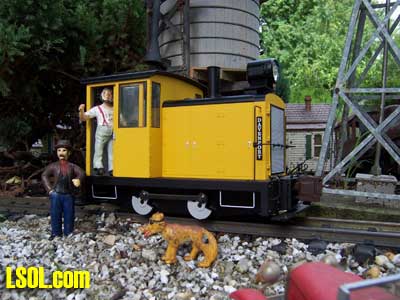 BACKGROUND:
Quoted from Wikipedia: The Davenport Locomotive Works, of Davenport, Iowa, built locomotives from 1902 until 1956. The company acquired the locomotive business of H. K. Porter, Inc. in 1950 and from then on produced Porter designs as well as its own. The company built small steam locomotives early on, the first gas-fueled internal combustion engine locomotives were built in 1924 and the first diesel locomotive in 1927, a 30-ton diesel-electric for the Northern Illinois Coal Company of Boonville, Indiana. Quoted from Bachmann Industries:
Faced with unprecedented economic pressure at the end of the steam era, locomotive manufacturers developed a variety of fuel and engine alternatives in search of a locomotive power plant that could successfully compete in the industrial market The Davenport 0-4-0 Side Rod Gas Mechanical was one of the early non-steam locomotives that quickly proved its worth in mining, industrial, and agricultural applications. Based on a 1940s stock model from the Davenport catalog, this 0-4-0 features the counterweights and side-rod configuration that distinguishes many transition-era locomotives. WATCH THE VIDEO TABULATED DATA:
Length: 9 1/4 inches
(measured from coupler to coupler) Length: 7 13/16 inches
measured from footboard to footboard)
Width: 3 13/16 inches
Height: 5 1/4 inches
(measured to top of headlight)
Weight: 3 pounds, 15 ounces
Drivers: 1.022 inches in diameter (they are small)
Wheel Base: 2 1/8 inches
Wheel Gauge: Front axle 1.572 inches, Rear axle 1.564" ( back to back gauge, G1MRA is 1.575)
PACKAGING:
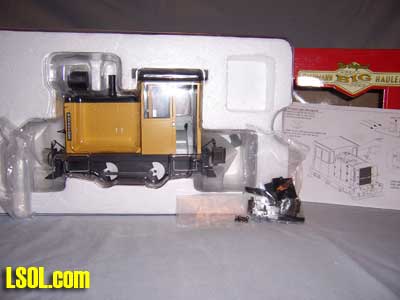 The Davenport comes well packaged. It arrived with no damage. Since this is not a Spectrum model what you get with the locomotive is sparse. There is no Owner's Manual or lubrication instructions. Also, no DVD that is supplied with the Spectrum models. No engineer figure, even the little one, supplied with the engine. But, you do get a vial of smoke fluid. There is a single sheet that contains information on installing a DCC decoder along with information on exchanging the couplers to the offset shank versions. The offset shank couplers would be used so that the locomotive's coupler height would align with rolling stock that has truck mounted couplers. The reverse side of the sheet is an exploded parts diagram of the Davenport. 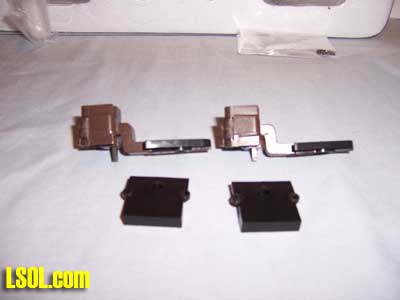 As mentioned, a set of offset shank couplers along with longer cut lever chains is included. These are pictured above. Changing couplers is a simple matter of removing two coupler box screws, exchange the couplers, and put the covers back in place. Change out the cut lever chains and you are in business with the offset couplers.
THE OUTSIDE:
First, it should be mentioned that the chassis and gear case are die-cast. Counterweights and side rods are metal as well as hand rails, cut levers, and strap steps. The cab, hood, headlight, and footboards are plastic. It appears that using an all metal chassis was one way to gain some additional weight for the locomotive. 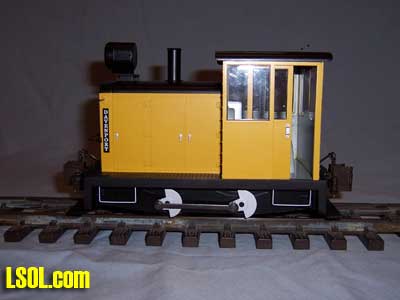 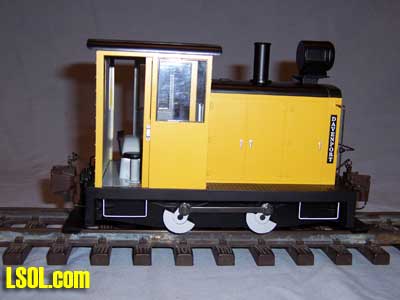
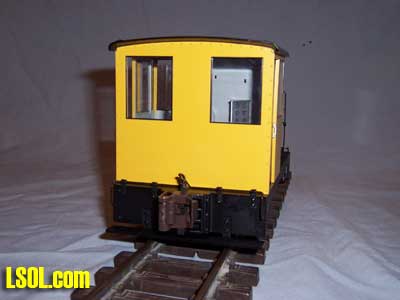 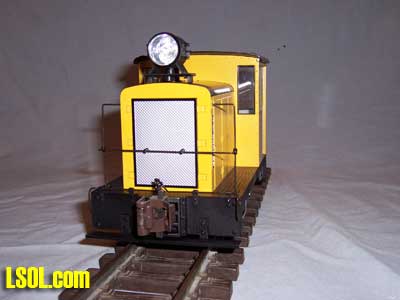 The four pictures above provide a view as you move around the Davenport. There really isn't much detail on a locomotive of this type. The castings are clean and crisp. Service door detail on the hood along with the radiator are well defined. You can pass judgement on that headlight! It sure is large. On the other hand, Glenn Habrial posted a picture of a Davenport with a headlight that sure looks like the one on the Bachmann model.
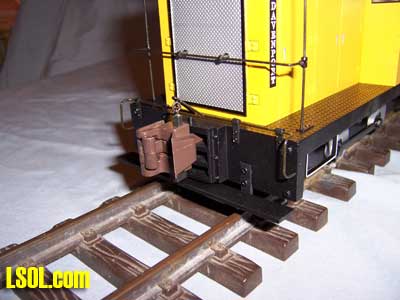 This is a view of the front pilot with the straight shank coupler in place. Note the cut lever and knuckle coupler pin lift chain. 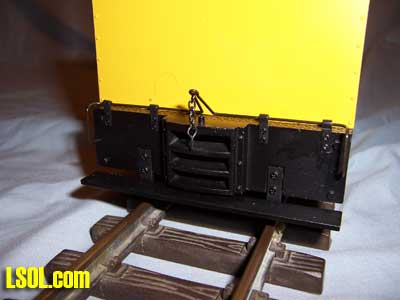 In this view the rear coupler has been removed to show the three pocket link and pin draw head. For those who want to use link and pin the draw heads are in place. However, there is no hole down through the draw head for the pin. It will be necessary to drill the hole to accommodate the pin for link and pin usage. That should be no big deal.
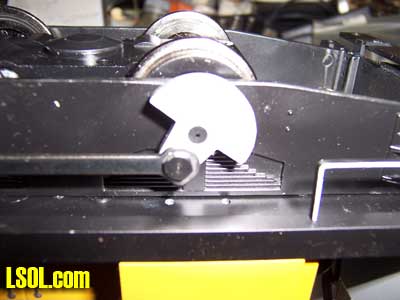 This is a view of a counterweight. As mentioned, the counterweights and side rods are metal. Note in the center of the counterweight is a small black plug. This plug covers the Phillips head screw that attaches the counterweight and driver to the axle. This small plug is removed to check screw tightness and/or remove the counterweight and driver wheel from the axle. In checking the four screws on the Davenport, all attaching screws were tight. I did not see fit to use any Loctite on the screws.
INSIDE LOOK: 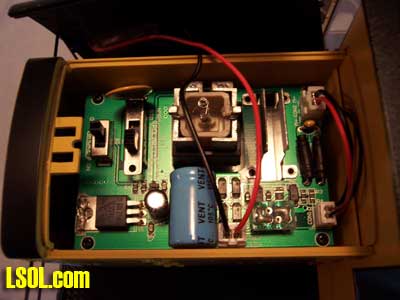 This is the main PCB. It contains among other things the switch for polarity, either NMRA or Large Scale, with a center OFF position. The other switch is the smoke On or OFF switch. On the left side, just to the rear of the headlight plug with the white and red wires is the dummy plug that would be removed to install an eight pin decoder. Also note a silver clip that is to be used to hold the decoder. So, the Davenport is set up to use an 8 pin decoder for all you DCC operators. There is also a very small smoke unit. Running on track power, at less than MACH 1 speeds the smoke unit is in keeping with Bachmann's tradition. The unit doesn't smoke, at least not much. 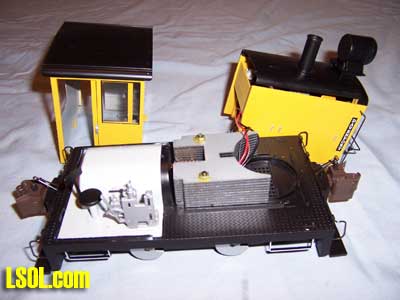 Here the hood top, hood, and cab have been removed. The hood and cab are held in place by eight screws. There are four screws that secure the hood and four that secure the cab. These screws are removed by turning the engine upside down. These are very small screws so be careful not to lose them. Removing and installing the hood and cab is a simple matter since everything lines right up when putting the components back in place. Should note that the hood top is removed by pulling up on the smoke stack.
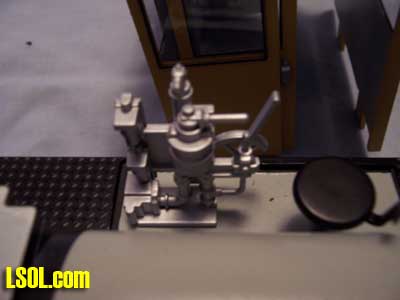 This is a view of the cab floor. Note the control stand and the seat for the engineer. The "hump" in the middle covers the motor. There are also two additional engine gauge controls molded to the front cab wall. 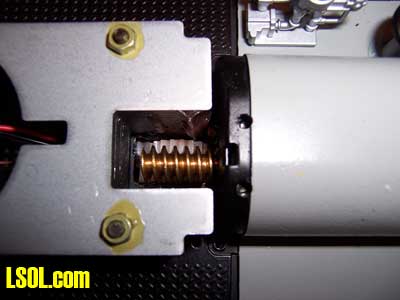 This is a top view of the motor with its worm drive showing. It should be noted that Bachmann has changed the design of the drive system on the Davenport. Unlike most other locomotives, the motor is mounted to the chassis. It is not part of the gear case as we are used to seeing on other locomotives. No longer, on this engine, is the motor a part of the gear case. 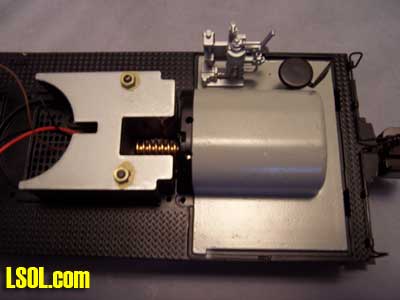 Another view of the motor worm gear as well as the stacked weights just to the front of the worm gear. The stacked weights are steel plates that are held in place by two screws with nuts that attach the weights to the chassis.
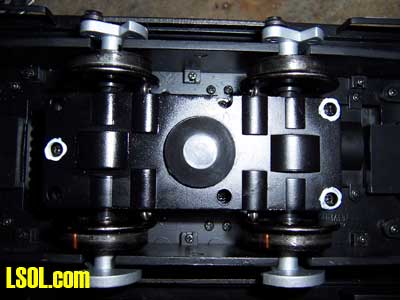 Turning the engine upside down you can see the gear case. As previously noted the gear case no longer contains the motor. The three screws that hold the gear case cover in place are highlighted with white. Removing these three screws gives access to the gear case. To lubricate the drive gears and axles it is only necessary to remove these three screws. Also, note lubrication plug in the center of the cover. The gear train can be lubricated by removing this plug. 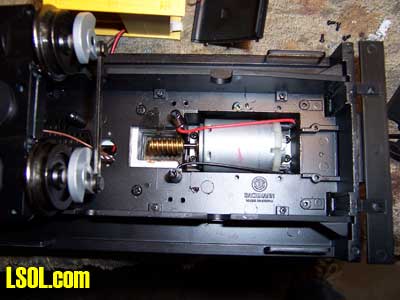 For this review the gear case was removed to give a better view of the motor from the bottom. Motor is held in place by a motor mount at each end. There are two screws in each motor mount. As designed, I see no problem with the motor moving out of mesh with the main drive gear. On this unit the four motor mount screws were tight, something that was not always the case with previous Bachmann locomotives and the motor to gear case mounting. There are four screws that secure the gear case to the chassis. By removing these screws it was possible to see the bottom of the motor once a small cover plate was removed from over the motor. Should also note that the gear case is metal along with its cover.
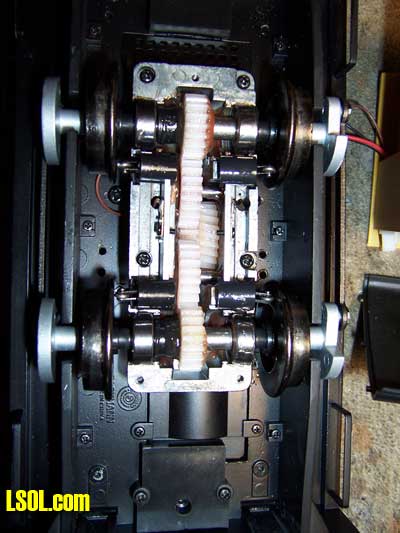 This is the "heart" of the Davenport's drive system. Note that both axles are gear driven. Axles run in ball bearings. Electrical pickups at the wheels are the little rollers that Bachmann has used on some of its most recent locomotives. When the gear case is mounted to the chassis the main gear meshes with the worm gear on the motor. It appears that this drive system should be robust. Only time will tell. The gears in the case were well lubricated. I added some heavy gear oil and a little more gear grease but that probably was not necessary. 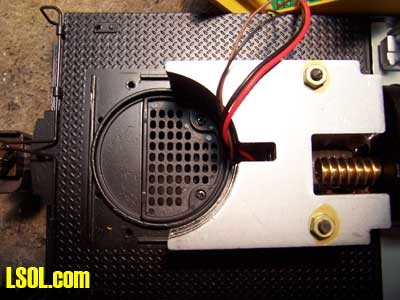 One last picture showing detail. This is the speaker grill. The speaker opening is 1 1/2 inch. That's going to be one small speaker. If running analog or battery power, finding a location for a sound card will take some thought. It's going to be a tight fit finding a place for just about any manufacturer's sound card.
FINAL THOUGHTS AND OBSERVATIONS:
I was surprised how well the Davenport ran using track power on some very dirty track. The locomotive did hesitate, when running slow, going through two Aristo-Craft extra wide radius switches. It handled the other extra wide radius switches and the number 6 switches without hesitation. The locomotive started to move at 2.8 to 3.0 volts of track power. That may be due to the engine needing more break in and condition of the track. With the exception of the two Aristo switches the locomotive pulled three 1:20.3 scale cars at 9 scale miles per hour without any hesitation. Track voltage at 9 scale miles per hour was around 6.2 volts. That voltage had to be varied slightly to maintain the 9 MPH as the engine traveled the layout.  Bachmann cut some corners by not providing a Owner's Manual, lubrication information, and some type of engineer figure. The headlight is just a little too large to my way of thinking. However, Glenn did publish a picture of a very similar Davenport with a headlight that seems to be a match for the one on this Bachmann model. Also, this is yet another switcher that comes without a backup light. How much additional expense would there have been to include a backup light? Well, that will give new owners something to do installing a proper backup light. For the money the Davenport seems to be a good value. Having only very limited run time the engine seems to be well suited to take on yard duties or to serve as a mine or industrial engine. I am impressed with the drive system, it sure seems to be robust. Also, with its short wheelbase, 2 1/8 inches, along with the weight being centered over the drivers the Davenport should handle loads normally associated with small locomotives of this type.
| Davenport Switcher |
| JD, Great review. I don't think I will buy one of them, but you certainly did a good job of telling us the details about the loco. Thanks, Noel |
| Noel Widdifield - 10/01/2008 - 04:38 |
| Davenport Dismal |
| Jon Excellent review and nice photo's.Not going to purchase one for 2 reasons not a spectrum series and I am not a fan of Diesels.I am sure Scott will purchase one.He may already have one and painted blue. Gator |
| Bob Gentile - 10/01/2008 - 05:37 |
| comments on the Davenport |
| Jon...A well covered review on a object so small, yet fully packed above and beyond...(provisions for a sound system ?). Which brings me to the "Why?". Why produce a very well made little shifter, and then while I know there is a market for well detailed little expensive locomotives (which is already filled), there is also a large and getting larger every day group of finacialy strapped large scalers, who would love to have something that just goes around the Christmas tree, and has a cost of between 50 and 75 dollars, top ? And has nothing on it but a plastic top and a wheelbase...HLW does it...why not you, Bachmann ? Thanks, Jon for the good review, but no thanks to Bachmann for an expensive and overloaded, but charming gas switcher. |
| kirke fay - 10/01/2008 - 16:17 |
| Thanks |
| Jon, nice review. Thanks for taking the time to tear apart your new toy and show us. I know I commented about the large headlight, and yea it may be prototypical, but I see if one happens to end up on the P&CS that will get changed out. Maybe I could sneak it into the roster here since its not a diesel but a gas-mechanical :D I can see that being a valuable yard goat for those who like to do switch yard work. These little locos were actually common but they didn't get the press that something like a K4 or the like got. Thanks again |
| David A. Maynard - 10/01/2008 - 16:19 |
| Davenport Switcher |
| JD: Nice review, I'll stick to my LGB Cat switcher. These will make a great shop goat. |
| Jim O'Connor - 10/01/2008 - 16:39 |
| review |
| Strange little engine, but good review. |
| John Damkier - 10/05/2008 - 09:41 |
| Davenport Switcher |
| Wonder how this short small wheelbase will work at prototypical speeds over a larger turnout? Nice little toy, but these usually do not run very well at prototypical speeds. Would need track power because use of onboard battery and receiver unit would be very limited. I won't get one but I am sure a lot will be running around the Christmas tree this year. Nicer review Jon |
| KC - 10/07/2008 - 08:19 |
| Davenport Negotiating Switches |
| KC, You are correct. With its short wheelbase the Davenport will require switches that are without fault. The Davenport will no through Aristo Extra Wide Radius and #6 switches at a scale 9 miles per hour. I had two extra wide switches where it would stall at 9 MPH. The rest of the switches caused no problem. Switches will have to be very clean with no electrical problems. At 12 scale MPH the Davenport negotiated all switches with a slight hesitation on the two that caused the locomotive to stall at 9 MPH. Sliders have been suggested. Could be done. However, installing sliders will take some extra effort since the case is metal. The sliders will have to be insulated from their mounts or they will short on the case. I think with some creative engineering RC and battery could be installed. Don't know if I would be willing to make that effort. |
| JD Miller - 10/07/2008 - 10:01 |
| Bachmann Davenport Switcher |
| J.D, I just received my Bachmann Davenport Switcher. After reading your review I am looking forward to running it, but will have to wait until May since I have no track or power down here in Florida. It is a neat looking little switcher. Micro-Mark had them on sale for $127.95 each. Mine is silver and black and looks great. Noel |
| Noel Widdifield - 02/12/2009 - 11:02 |
Top of Page
|



